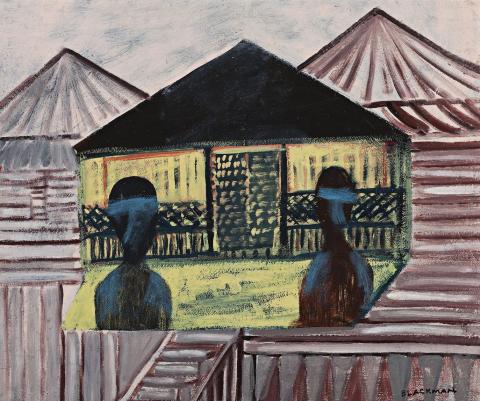SPRING HILL WITH FIGURES, 1952
CHARLES BLACKMAN
oil on board
62.0 x 74.5 cm
signed lower right: BLACKMAN
Collection of the artist
Barbara Blackman, Melbourne
Eastgate Gallery, Melbourne
Private collection, Melbourne
Melbourne Fine Art Gallery, Melbourne
Lauraine Diggins Fine Art, Melbourne (label attached verso)
Private collection, Melbourne
Lure of the Sun: Charles Blackman in Queensland, Queensland Art Gallery, Brisbane, 7 November 2015 – 31 January 2016
‘I think that Queensland probably had the best influence on me as a person, its sunshine and its lightness and its colour and its friendly spirit probably helped me to flower as a personality in some way’.1
Charles Blackman first ventured to Queensland in 1948 at the age of twenty, eager to break away from the familiarity of Sydney and lured by the vibrant creative scene nourished by the Barjai literary and artistic group. In Brisbane, Blackman discovered a vivacious circle of artists, poets, philosophers and writers including artist Laurence Hope, poet Judith Wright and his future wife, Barbara Patterson. This assorted group encouraged Blackman’s emerging style, introducing him to the beauty and vitality of Australia’s north and remaining important to the artist’s practice throughout his career. Blackman soon married Barbara, subsequently moving to Melbourne where he established a home and studio. Barbara’s family resided in Brisbane, enabling an ongoing connection with the city and the couple returned to Queensland in the winter of 1952, where Blackman painted a small group of works amid the distinctive houses of Spring Hill, portraying the warm simplicity of subtropical Brisbane.
The vernacular architecture of the charming ‘Queenslander’ home, responding to the local climatic and cultural needs of mid-19th century Queensland, was a subject fundamental to Blackman’s depictions of the Sunshine State. Wide verandahs and steeply pitched corrugated roofs were purposely designed to be hardy and rugged like the people inhabiting them. The distinctive silhouette of the 'slanting, slatting, latticed timber houses’2 was conducive to Blackman’s developing artistic voice, with a geometric quality that would become a defining feature of the artist’s style. In the present work fence posts, weatherboards and steep front steps form rhythmic patterns which frame the central figures within the urban landscape.
Blackman’s time in Queensland was vital to subsequent developments in his work, as confirmed by the exhibition Lure of the Sun: Charles Blackman in Queensland at the Queensland Art Gallery in 2016. The exhibition highlighted the powerful impact that Brisbane had on the artist, both on and off the canvas, particularly in the friendships forged there, and his becoming acquainted with notable influences including Sidney Nolan. Nolan’s paintings, first viewed by Blackman in Brisbane, introduced the young artist to a poetic and allegorical method of expression.
There are notable parallels between the paintings Blackman produced in Brisbane and his ensuing work, including the famed Schoolgirl series which immediately followed the Queensland sojourn in 1952. The figures in the present work are veiled in menacing shadows, conjuring the same sense of unease which pervaded the Schoolgirl paintings. Similarly isolated and cloaked in obscurity, the figures here are a precursor to the later school children who inhabited deserted locales. A strong use of pattern points to the uniform pleats and sharp repetitive rooftops recurrent in the Schoolgirl series, while the harsh light and ominous shadows, together with unexpected colour combinations seen here, remained a significant feature of the artist’s oeuvre. An important work from Blackman’s formative years, Spring Hill with Figures, 1952 is a fascinating signal of things to come for a promising young artist on the path to a prodigious career.
1. The artist quoted in Hawker, M., Lure of the Sun: Charles Blackman in Queensland, exhibition catalogue, Queensland Art Gallery, 2015, p. 16
2. Shapcott, T., Focus on Charles Blackman, University of Queensland Press, Brisbane, 1967, p. 16
MELISSA HELLARD
